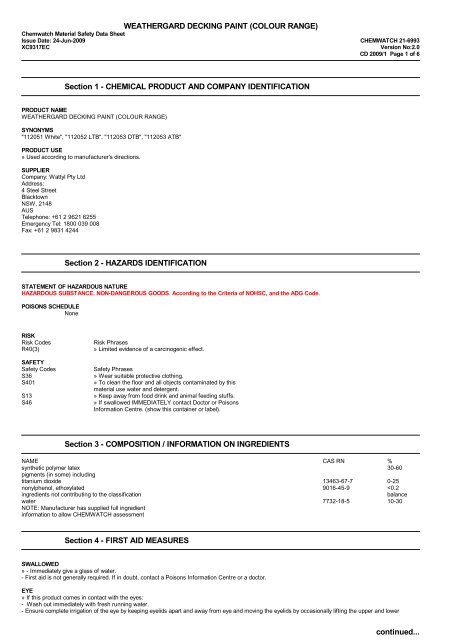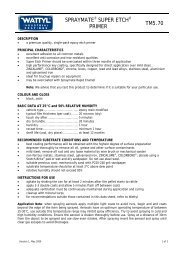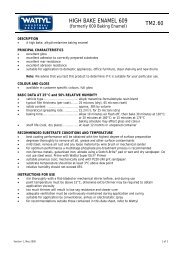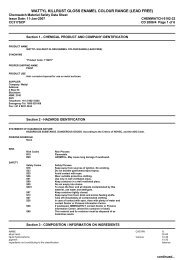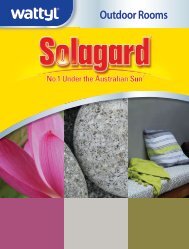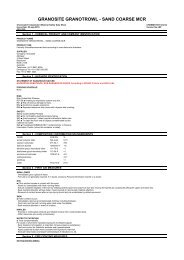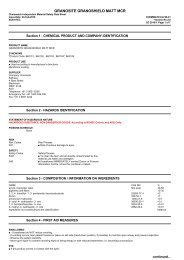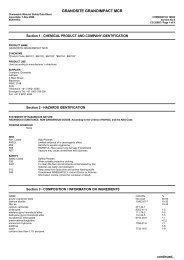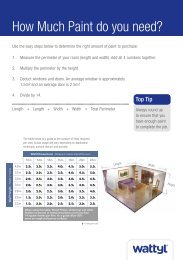Chemwatch Australian MSDS 21-6993 - Wattyl
Chemwatch Australian MSDS 21-6993 - Wattyl
Chemwatch Australian MSDS 21-6993 - Wattyl
You also want an ePaper? Increase the reach of your titles
YUMPU automatically turns print PDFs into web optimized ePapers that Google loves.
WEATHERGARD DECKING PAINT (COLOUR RANGE)<strong>Chemwatch</strong> Material Safety Data SheetIssue Date: 24-Jun-2009 CHEMWATCH <strong>21</strong>-<strong>6993</strong>XC9317ECVersion No:2.0CD 2009/1 Page 1 of 6Section 1 - CHEMICAL PRODUCT AND COMPANY IDENTIFICATIONPRODUCT NAMEWEATHERGARD DECKING PAINT (COLOUR RANGE)SYNONYMS"112051 White", "112052 LTB", "112053 DTB", "112053 ATB"PRODUCT USE» Used according to manufacturer's directions.SUPPLIERCompany: <strong>Wattyl</strong> Pty LtdAddress:4 Steel StreetBlacktownNSW, <strong>21</strong>48AUSTelephone: +61 2 96<strong>21</strong> 6255Emergency Tel: 1800 039 008Fax: +61 2 9831 4244Section 2 - HAZARDS IDENTIFICATIONSTATEMENT OF HAZARDOUS NATUREHAZARDOUS SUBSTANCE. NON-DANGEROUS GOODS. According to the Criteria of NOHSC, and the ADG Code.POISONS SCHEDULENoneRISKRisk CodesR40(3)SAFETYSafety CodesS36S401S13S46Risk Phrases» Limited evidence of a carcinogenic effect.Safety Phrases» Wear suitable protective clothing.» To clean the floor and all objects contaminated by thismaterial use water and detergent.» Keep away from food drink and animal feeding stuffs.» If swallowed IMMEDIATELY contact Doctor or PoisonsInformation Centre. (show this container or label).Section 3 - COMPOSITION / INFORMATION ON INGREDIENTSNAME CAS RN %synthetic polymer latex 30-60pigments (in some) includingtitanium dioxide 13463-67-7 0-25nonylphenol, ethoxylated 9016-45-9
WEATHERGARD DECKING PAINT (COLOUR RANGE)<strong>Chemwatch</strong> Material Safety Data SheetIssue Date: 24-Jun-2009 CHEMWATCH <strong>21</strong>-<strong>6993</strong>XC9317ECVersion No:2.0CD 2009/1 Page 2 of 6Section 4 - FIRST AID MEASURESlids.- If pain persists or recurs seek medical attention.- Removal of contact lenses after an eye injury should only be undertaken by skilled personnel.SKIN» If skin contact occurs:- Immediately remove all contaminated clothing, including footwear.- Flush skin and hair with running water (and soap if available).- Seek medical attention in event of irritation.INHALED» - If fumes or combustion products are inhaled remove from contaminated area.- Other measures are usually unnecessary.NOTES TO PHYSICIAN» Treat symptomatically.Section 5 - FIRE FIGHTING MEASURESEXTINGUISHING MEDIA» - There is no restriction on the type of extinguisher which may be used.- Use extinguishing media suitable for surrounding area.FIRE FIGHTING» - Alert Fire Brigade and tell them location and nature of hazard.- Wear breathing apparatus plus protective gloves for fire only.- Prevent, by any means available, spillage from entering drains or water courses.- Use fire fighting procedures suitable for surrounding area.FIRE/EXPLOSION HAZARD» - Non combustible.- Not considered a significant fire risk, however containers may burn.May emit poisonous fumes.May emit corrosive fumes.FIRE INCOMPATIBILITY» None known.HAZCHEM: NoneSection 6 - ACCIDENTAL RELEASE MEASURESEMERGENCY PROCEDURESMINOR SPILLS» - Clean up all spills immediately.- Avoid breathing vapours and contact with skin and eyes.- Control personal contact by using protective equipment.- Contain and absorb spill with sand, earth, inert material or vermiculite.MAJOR SPILLS» Moderate hazard.- Clear area of personnel and move upwind.- Alert Fire Brigade and tell them location and nature of hazard.- Wear breathing apparatus plus protective gloves.- Prevent, by any means available, spillage from entering drains or water course.Personal Protective Equipment advice is contained in Section 8 of the <strong>MSDS</strong>.Section 7 - HANDLING AND STORAGEPROCEDURE FOR HANDLING» - Avoid all personal contact, including inhalation.- Wear protective clothing when risk of exposure occurs.- Use in a well-ventilated area.- Avoid contact with moisture.- DO NOT allow clothing wet with material to stay in contact with skin.SUITABLE CONTAINER» - Polyethylene or polypropylene container.- Packing as recommended by manufacturer.continued...
WEATHERGARD DECKING PAINT (COLOUR RANGE)<strong>Chemwatch</strong> Material Safety Data SheetIssue Date: 24-Jun-2009 CHEMWATCH <strong>21</strong>-<strong>6993</strong>XC9317ECVersion No:2.0CD 2009/1 Page 3 of 6Section 7 - HANDLING AND STORAGE- Check all containers are clearly labelled and free from leaks.STORAGE INCOMPATIBILITY» None known.STORAGE REQUIREMENTS» - Store in original containers.- Keep containers securely sealed.- Store in a cool, dry, well-ventilated area.- Store away from incompatible materials and foodstuff containers.Section 8 - EXPOSURE CONTROLS / PERSONAL PROTECTIONEXPOSURE CONTROLSSource Material TWA mg/m³___________ ___________ _______Australia Exposure Standards titanium dioxide (Titanium dioxide (a)) 10The following materials had no OELs on our records• nonylphenol, ethoxylated: CAS:9016- 45- 9 CAS:26027- 38- 3• water: CAS:7732- 18- 5PERSONAL PROTECTIONRESPIRATORType A-P Filter of sufficient capacityEYE» - Safety glasses with side shields.- Chemical goggles.- Contact lenses may pose a special hazard; soft contact lenses may absorb and concentrate irritants. A written policy document, describing thewearing of lens or restrictions on use, should be created for each workplace or task. This should include a review of lens absorption and adsorptionfor the class of chemicals in use and an account of injury experience. Medical and first-aid personnel should be trained in their removal andsuitable equipment should be readily available. In the event of chemical exposure, begin eye irrigation immediately and remove contact lens as soonas practicable. Lens should be removed at the first signs of eye redness or irritation - lens should be removed in a clean environment only afterworkers have washed hands thoroughly. [CDC NIOSH Current Intelligence Bulletin 59].HANDS/FEET» - Wear chemical protective gloves, eg. PVC.- Wear safety footwear or safety gumboots, eg. Rubber.NOTE:- The material may produce skin sensitisation in predisposed individuals. Care must be taken, when removing gloves and other protective equipment, toavoid all possible skin contact.- Contaminated leather items, such as shoes, belts and watch-bands should be removed and destroyed.Suitability and durability of glove type is dependent on usage. Factors such as:- frequency and duration of contact,- chemical resistance of glove material,- glove thickness and- dexterity,OTHER» - Overalls.- P.V.C. apron.- Barrier cream.- Skin cleansing cream.ENGINEERING CONTROLS» General exhaust is adequate under normal operating conditions. Local exhaust ventilation may be required in specific circumstances.Section 9 - PHYSICAL AND CHEMICAL PROPERTIESAPPEARANCEWhite or coloured liquid water paint with a mild acrylic odour; miscible with water.PHYSICAL PROPERTIESLiquid.Mixes with water.Molecular Weight: Not applicable.Boiling Range (°C): 100 water.Melting Range (°C): Not available. Specific Gravity (water=1): 1.1- 1.6Solubility in water (g/L): Miscible pH (as supplied): 10pH (1% solution): Not availableVapour Pressure (kPa): Not available.Volatile Component (%vol): 30- 40Evaporation Rate: Not availablecontinued...
WEATHERGARD DECKING PAINT (COLOUR RANGE)<strong>Chemwatch</strong> Material Safety Data SheetIssue Date: 24-Jun-2009 CHEMWATCH <strong>21</strong>-<strong>6993</strong>XC9317ECVersion No:2.0CD 2009/1 Page 4 of 6Section 9 - PHYSICAL AND CHEMICAL PROPERTIESRelative Vapour Density (air=1): Not available.Lower Explosive Limit (%): Not applicableAutoignition Temp (°C): Not applicableState: LiquidFlash Point (°C): Non combustibleUpper Explosive Limit (%): Not applicableDecomposition Temp (°C): Not available.Viscosity: Not AvailableSection 10 - CHEMICAL STABILITY AND REACTIVITY INFORMATIONCONDITIONS CONTRIBUTING TO INSTABILITY» - Presence of incompatible materials.- Product is considered stable.- Hazardous polymerisation will not occur.For incompatible materials - refer to Section 7 - Handling and Storage.Section 11 - TOXICOLOGICAL INFORMATIONPOTENTIAL HEALTH EFFECTSACUTE HEALTH EFFECTSCHRONIC HEALTH EFFECTS» Not applicable. » Limited evidence of a carcinogenic effect.TOXICITY AND IRRITATION» unless otherwise specified data extracted from RTECS - Register of Toxic Effects of Chemical Substances.» The material may produce moderate eye irritation leading to inflammation. Repeated or prolonged exposure to irritants may produce conjunctivitis.The material may cause skin irritation after prolonged or repeated exposure and may produce a contact dermatitis (nonallergic). This form ofdermatitis is often characterised by skin redness (erythema) and swelling epidermis.TITANIUM DIOXIDE:» unless otherwise specified data extracted from RTECS - Register of Toxic Effects of Chemical Substances.TOXICITYIRRITATIONOral (Rat) LD50: >20000 mg/kg * Skin (human): 0.3 mg /3D (int)- Mild *Oral (Mouse) LD50: >10000 mg/kg *» The material may produce moderate eye irritation leading to inflammation. Repeated or prolonged exposure to irritants may produce conjunctivitis.The material may cause skin irritation after prolonged or repeated exposure and may produce a contact dermatitis (nonallergic). This form ofdermatitis is often characterised by skin redness (erythema) and swelling epidermis.For titanium dioxide:Humans can be exposed to titanium dioxide via inhalation, ingestion or dermal contact. In human lungs, the clearance kinetics of titanium dioxide ispoorly characterized relative to that in experimental animals.* IUCLIDNONYLPHENOL, ETHOXYLATED:» unless otherwise specified data extracted from RTECS - Register of Toxic Effects of Chemical Substances.TOXICITYOral (rat) LD50: >2000 mg/kgDermal (rabbit) LD50: 2830 ul/kgIRRITATIONSkin (human): 15 mg/3D MildSkin (rabbit): 500 mg MildEye (rabbit): 5 mg SEVERE» The material may produce severe irritation to the eye causing pronounced inflammation. Repeated or prolonged exposure to irritants may produceconjunctivitis.The material may cause skin irritation after prolonged or repeated exposure and may produce a contact dermatitis (nonallergic). This form ofdermatitis is often characterised by skin redness (erythema) and swelling epidermis.WATER:» No significant acute toxicological data identified in literature search.CARCINOGENtitanium dioxide International Agency for Research on Cancer Group 2B(IARC) CarcinogensNo dataSection 12 - ECOLOGICAL INFORMATIONcontinued...
WEATHERGARD DECKING PAINT (COLOUR RANGE)<strong>Chemwatch</strong> Material Safety Data SheetIssue Date: 24-Jun-2009 CHEMWATCH <strong>21</strong>-<strong>6993</strong>XC9317ECVersion No:2.0CD 2009/1 Page 5 of 6Section 13 - DISPOSAL CONSIDERATIONS» - Containers may still present a chemical hazard/ danger when empty.- Return to supplier for reuse/ recycling if possible.Otherwise:- If container can not be cleaned sufficiently well to ensure that residuals do not remain or if the container cannot be used to store the sameproduct, then puncture containers, to prevent re-use, and bury at an authorised landfill.- Where possible retain label warnings and <strong>MSDS</strong> and observe all notices pertaining to the product.- Recycle wherever possible.- Consult manufacturer for recycling options or consult local or regional waste management authority for disposal if no suitable treatment ordisposal facility can be identified.- Dispose of by: Burial in a licenced land-fill or incineration in a licenced apparatus (after admixture with suitable combustible material).- Decontaminate empty containers. Observe all label safeguards until containers are cleaned and destroyed.HAZCHEM: None (ADG6)Section 14 - TRANSPORTATION INFORMATIONNOT REGULATED FOR TRANSPORT OF DANGEROUS GOODS: UN, IATA, IMDGSection 15 - REGULATORY INFORMATIONPOISONS SCHEDULE: NoneREGULATIONSRegulations for ingredientsWeathergard Decking Paint (Colour Range) (CAS: None):No regulations applicabletitanium dioxide (CAS: 13463-67-7) is found on the following regulatory lists;Australia Exposure StandardsAustralia High Volume Industrial Chemical List (HVICL)Australia Inventory of Chemical Substances (AICS)Australia Standard for the Uniform Scheduling of Drugs and Poisons (SUSDP) - Schedule 4Australia Standard for the Uniform Scheduling of Drugs and Poisons (SUSDP) - Schedule 5Australia Standard for the Uniform Scheduling of Drugs and Poisons (SUSDP) - Schedule 7Australia Therapeutic Goods Administration (TGA) Substances that may be used as active ingredients in Listed medicinesAustralia Therapeutic Goods Administration (TGA) Sunscreening agents permitted as active ingredients in listed productsCODEX General Standard for Food Additives (GSFA) - Additives Permitted for Use in Food in General, Unless Otherwise Specified, in Accordance withGMPIMO IBC Code Chapter 17: Summary of minimum requirementsInternational Agency for Research on Cancer (IARC) CarcinogensOECD Representative List of High Production Volume (HPV) Chemicalstitanium dioxide (CAS: 1317-70-0) is found on the following regulatory lists;Australia Inventory of Chemical Substances (AICS)OECD Representative List of High Production Volume (HPV) Chemicalstitanium dioxide (CAS: 1317-80-2) is found on the following regulatory lists;Australia Inventory of Chemical Substances (AICS)Australia Standard for the Uniform Scheduling of Drugs and Poisons (SUSDP) - Schedule 4Australia Standard for the Uniform Scheduling of Drugs and Poisons (SUSDP) - Schedule 5Australia Standard for the Uniform Scheduling of Drugs and Poisons (SUSDP) - Schedule 7OECD Representative List of High Production Volume (HPV) Chemicalstitanium dioxide (CAS: 1309-63-3) is found on the following regulatory lists;Australia Standard for the Uniform Scheduling of Drugs and Poisons (SUSDP) - Schedule 4Australia Standard for the Uniform Scheduling of Drugs and Poisons (SUSDP) - Schedule 5Australia Standard for the Uniform Scheduling of Drugs and Poisons (SUSDP) - Schedule 7titanium dioxide (CAS: 62338-64-1) is found on the following regulatory lists;Australia Standard for the Uniform Scheduling of Drugs and Poisons (SUSDP) - Schedule 4Australia Standard for the Uniform Scheduling of Drugs and Poisons (SUSDP) - Schedule 5Australia Standard for the Uniform Scheduling of Drugs and Poisons (SUSDP) - Schedule 7nonylphenol, ethoxylated (CAS: 9016-45-9) is found on the following regulatory lists;Australia High Volume Industrial Chemical List (HVICL)Australia Inventory of Chemical Substances (AICS)OECD Representative List of High Production Volume (HPV) ChemicalsOSPAR List of Chemicals for Priority ActionOSPAR List of Substances of Possible Concernnonylphenol, ethoxylated (CAS: 26027-38-3) is found on the following regulatory lists;Australia Inventory of Chemical Substances (AICS)Australia Standard for the Uniform Scheduling of Drugs and Poisons (SUSDP) - Appendix E (Part 2)Australia Standard for the Uniform Scheduling of Drugs and Poisons (SUSDP) - Schedule 5Australia Standard for the Uniform Scheduling of Drugs and Poisons (SUSDP) - Schedule 6IMO Provisional Categorization of Liquid Substances - List 1: Pure or technically pure productsInternational Chemical Secretariat (ChemSec) REACH SIN* List (*Substitute It Now!) 1.0OSPAR List of Chemicals for Priority Actionwater (CAS: 7732-18-5) is found on the following regulatory lists;Australia Inventory of Chemical Substances (AICS)IMO IBC Code Chapter 18: List of products to which the Code does not applycontinued...
WEATHERGARD DECKING PAINT (COLOUR RANGE)<strong>Chemwatch</strong> Material Safety Data SheetIssue Date: 24-Jun-2009 CHEMWATCH <strong>21</strong>-<strong>6993</strong>XC9317ECVersion No:2.0CD 2009/1 Page 6 of 6Section 15 - REGULATORY INFORMATIONOECD Representative List of High Production Volume (HPV) ChemicalsNo data available for titanium dioxide as CAS: 1<strong>21</strong>88-41-9, CAS: 100292-32-8, CAS: 101239-53-6, CAS: 116788-85-3, CAS: 12000-59-8, CAS: 12701-76-7,CAS: 12767-65-6, CAS: 12789-63-8, CAS: 1344-29-2, CAS: 185323-71-1, CAS: 185828-91-5, CAS: 188357-76-8, CAS: 188357-79-1, CAS: 195740-11-5, CAS:2<strong>21</strong>548-98-7, CAS: 224963-00-2, CAS: 246178-32-5, CAS: 252962-41-7, CAS: 37230-92-5, CAS: 37230-94-7, CAS: 37230-95-8, CAS: 37230-96-9, CAS: 39320-58-6, CAS: 39360-64-0, CAS: 39379-02-7, CAS: 416845-43-7, CAS: 494848-07-6, CAS: 494848-23-6, CAS: 494851-77-3, CAS: 494851-98-8, CAS: 55068-84-3, CAS:55068-85-4, CAS: 552316-51-5, CAS: 767341-00-4, CAS: 97929-50-5, CAS: 98084-96-9.Section 16 - OTHER INFORMATIONINGREDIENTS WITH MULTIPLE CAS NUMBERSIngredient NameCAStitanium dioxide 13463- 67- 7, 1317- 70- 0, 1317- 80- 2, 1<strong>21</strong>88- 41- 9, 1309- 63- 3,100292- 32- 8, 101239- 53- 6, 116788- 85- 3, 12000- 59- 8, 12701- 76-7, 12767- 65- 6, 12789- 63- 8, 1344- 29- 2, 185323- 71- 1, 185828- 91-5, 188357- 76- 8, 188357- 79- 1, 195740- 11- 5, 2<strong>21</strong>548- 98- 7, 224963-00- 2, 246178- 32- 5, 252962- 41- 7, 37230- 92- 5, 37230- 94- 7,37230- 95- 8, 37230- 96- 9, 39320- 58- 6, 39360- 64- 0, 39379- 02- 7,416845- 43- 7, 494848- 07- 6, 494848- 23- 6, 494851- 77- 3, 494851-98- 8, 55068- 84- 3, 55068- 85- 4, 552316- 51- 5, 62338- 64- 1,767341- 00- 4, 97929- 50- 5, 98084- 96- 9nonylphenol, 9016- 45- 9, 26027- 38- 3ethoxylated» Classification of the preparation and its individual components has drawn on official and authoritative sources as well as independent review bythe <strong>Chemwatch</strong> Classification committee using available literature references.A list of reference resources used to assist the committee may be found at:www.chemwatch.net/references.» The (M)SDS is a Hazard Communication tool and should be used to assist in the Risk Assessment. Many factors determine whether the reported Hazardsare Risks in the workplace or other settings.This document is copyright. Apart from any fair dealing for the purposes of private study, research, review orcriticism, as permitted under the Copyright Act, no part may be reproduced by any process without writtenpermission from CHEMWATCH. TEL (+61 3) 9572 4700.Issue Date: 24-Jun-2009Print Date: 24-Jun-2009This is the end of the <strong>MSDS</strong>.


